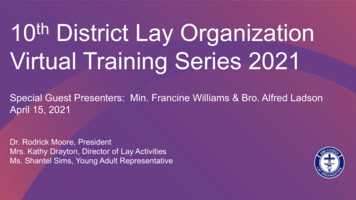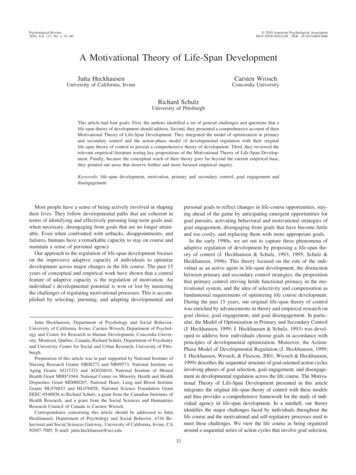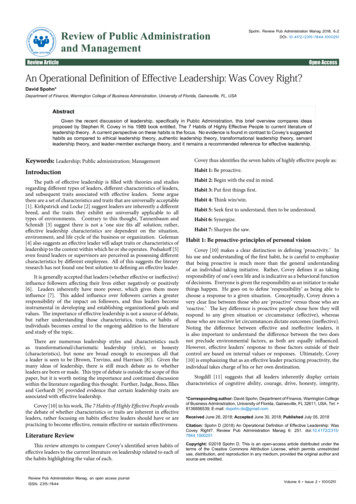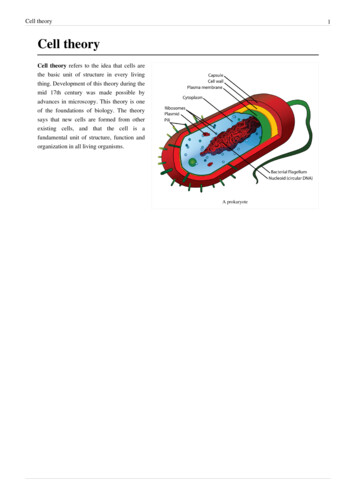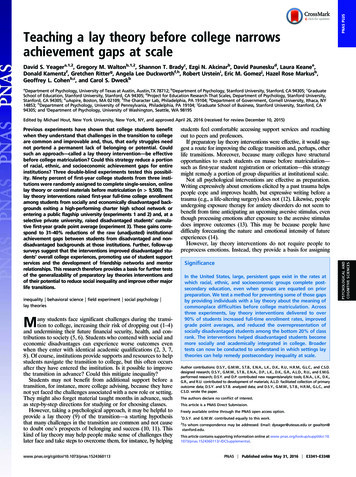
Transcription
PNAS PLUSTeaching a lay theory before college narrowsachievement gaps at scaleDavid S. Yeagera,1,2, Gregory M. Waltonb,1,2, Shannon T. Bradyc, Ezgi N. Akcinarb, David Pauneskud, Laura Keanee,Donald Kamentzf, Gretchen Ritterg, Angela Lee Duckworthf,h, Robert Ursteini, Eric M. Gomezj, Hazel Rose Markusb,Geoffrey L. Cohenb,c, and Carol S. DweckbaDepartment of Psychology, University of Texas at Austin, Austin,TX 78712; bDepartment of Psychology, Stanford University, Stanford, CA 94305; cGraduateSchool of Education, Stanford University, Stanford, CA 94305; dProject for Education Research That Scales, Department of Psychology, Stanford University,Stanford, CA 94305; euAspire, Boston, MA 02109; fThe Character Lab, Philadelphia, PA 19104; gDepartment of Government, Cornell University, Ithaca, NY14853; hDepartment of Psychology, University of Pennsylvania, Philadelphia, PA 19104; iGraduate School of Business, Stanford University, Stanford, CA94305; and jDepartment of Psychology, University of Washington, Seattle, WA 98195Edited by Michael Hout, New York University, New York, NY, and approved April 26, 2016 (received for review December 10, 2015) inequality behavioral sciencelay theoriesstudents feel comfortable accessing support services and reachingout to peers and professors.If preparatory lay theory interventions were effective, it would suggest a route for improving the college transition and, perhaps, otherlife transitions. Moreover, because many colleges have structuralopportunities to reach students en masse before matriculation—such as first-year student registration or orientation—this strategymight remedy a portion of group disparities at institutional scale.Not all psychological interventions are effective as preparation.Writing expressively about emotions elicited by a past trauma helpspeople cope and improves health, but expressive writing before atrauma (e.g., a life-altering surgery) does not (12). Likewise, peopleundergoing exposure therapy for anxiety disorders do not seem tobenefit from time anticipating an upcoming aversive stimulus, eventhough processing emotions after exposure to the aversive stimulusdoes improve outcomes (13). This may be because people havedifficulty forecasting the nature and emotional intensity of futureexperiences (14).However, lay theory interventions do not require people topreprocess emotions. Instead, they provide a basis for assigningSignificanceIn the United States, large, persistent gaps exist in the rates atwhich racial, ethnic, and socioeconomic groups complete postsecondary education, even when groups are equated on priorpreparation. We test a method for preventing some of those gapsby providing individuals with a lay theory about the meaning ofcommonplace difficulties before college matriculation. Acrossthree experiments, lay theory interventions delivered to over90% of students increased full-time enrollment rates, improvedgrade point averages, and reduced the overrepresentation ofsocially disadvantaged students among the bottom 20% of classrank. The interventions helped disadvantaged students becomemore socially and academically integrated in college. Broadertests can now be conducted to understand in which settings laytheories can help remedy postsecondary inequality at scale. field experiment social psychology Many students face significant challenges during the transition to college, increasing their risk of dropping out (1–4)and undermining their future financial security, health, and contributions to society (5, 6). Students who contend with social andeconomic disadvantages can experience worse outcomes evenwhen they enter with identical academic qualifications (2, 3, 7,8). Of course, institutions provide supports and resources to helpstudents navigate the transition to college, but this often occursafter they have entered the institution. Is it possible to improvethe transition in advance? Could this mitigate inequality?Students may not benefit from additional support before atransition, for instance, more college advising, because they havenot yet faced the challenges associated with a new role or setting.They might also forget material taught months in advance, suchas step-by-step directions for studying or for choosing classes.However, taking a psychological approach, it may be helpful toprovide a lay theory (9) of the transition—a starting hypothesisthat many challenges in the transition are common and not causeto doubt one’s prospects of belonging and success (10, 11). Thiskind of lay theory may help people make sense of challenges theylater face and take steps to overcome them, for instance, by 3Author contributions: D.S.Y., G.M.W., S.T.B., E.N.A., L.K., D.K., R.U., H.R.M., G.L.C., and C.S.D.designed research; D.S.Y., G.M.W., S.T.B., E.N.A., D.P., L.K., D.K., G.R., A.L.D., R.U., and E.M.G.performed research; D.S.Y. and D.P. contributed new reagents/analytic tools; E.N.A., L.K., D.K.,G.R., and R.U. contributed to development of materials; A.L.D. facilitated collection of primaryoutcome data; D.S.Y. and S.T.B. analyzed data; and D.S.Y., G.M.W., S.T.B., H.R.M., G.L.C., andC.S.D. wrote the paper.The authors declare no conflict of interest.This article is a PNAS Direct Submission.Freely available online through the PNAS open access option.1D.S.Y. and G.M.W. contributed equally to this work.2To whom correspondence may be addressed. Email: dyeager@utexas.edu or gwalton@stanford.edu.This article contains supporting information online at 113/-/DCSupplemental.PNAS Published online May 31, 2016 E3341–E3348PSYCHOLOGICAL ANDCOGNITIVE SCIENCESPrevious experiments have shown that college students benefitwhen they understand that challenges in the transition to collegeare common and improvable and, thus, that early struggles neednot portend a permanent lack of belonging or potential. Couldsuch an approach—called a lay theory intervention—be effectivebefore college matriculation? Could this strategy reduce a portionof racial, ethnic, and socioeconomic achievement gaps for entireinstitutions? Three double-blind experiments tested this possibility. Ninety percent of first-year college students from three institutions were randomly assigned to complete single-session, onlinelay theory or control materials before matriculation (n 9,500). Thelay theory interventions raised first-year full-time college enrollmentamong students from socially and economically disadvantaged backgrounds exiting a high-performing charter high school network orentering a public flagship university (experiments 1 and 2) and, at aselective private university, raised disadvantaged students’ cumulative first-year grade point average (experiment 3). These gains correspond to 31–40% reductions of the raw (unadjusted) institutionalachievement gaps between students from disadvantaged and nondisadvantaged backgrounds at those institutions. Further, follow-upsurveys suggest that the interventions improved disadvantaged students’ overall college experiences, promoting use of student supportservices and the development of friendship networks and mentorrelationships. This research therefore provides a basis for further testsof the generalizability of preparatory lay theories interventions andof their potential to reduce social inequality and improve other majorlife transitions.
meaning to experiences. Just as a scientific theory allows aresearcher to understand the causes and effects they observe intheir data (15), lay theories help people interpret adversities theyencounter—what caused the adversities and what they mean fortheir future (9). Even if people cannot remember step-by-stepdirections long in advance, it may be memorable and helpful tolearn that struggling in class or having difficulty making friendsdoes not mean that they, or people like them, are unintelligent ordo not belong.Lay theory interventions should benefit students most whohave the greatest reason to draw negative inferences from adversities in college and, therefore, may help reduce group-based inequalities (7). In the United States, students from racial/ethnicminority groups and those who would be the first in their families toearn a college degree (i.e., first-generation students) can face negative stereotypes about their intellectual ability, numeric underrepresentation, and other group-based threats on campus (2, 3,7, 16). This circumstance can lead students to worry whether theyand people like them can fully belong (11, 17), will be seen aslacking intelligence (7, 18, 19), or will be a poor cultural fit in college (20, 21). Although students from majority groups can experience personal worries about belonging and potential, they are lesslikely to experience these at the group level. Such concerns seedharmful inferences for even commonplace challenges in college suchas feelings of loneliness, academic struggles, or critical feedback:“Maybe this means people like me do not belong or cannot succeed.” These inferences sap motivation and undermine achievementthrough a cycle that gains strength through its repetition (22, 23).This process is depicted in Fig. 1, which highlights how problematic lay theories—arising from group-based experiences thatgive rise to persistent worries about belonging, potential, and cultural fit—can impede the social and academic integration critical tosuccess in college (4, 24), contributing to group-based inequality.As we have suggested, a corollary of the process in Fig. 1 is thatproviding people with an alternative lay theory—one that characterizes adversities as common and improvable—should reduce thoseinequalities. In small-scale trials, this strategy has been effectivewhen carried out as treatment. Specifically, interventions teachingan alternative lay theory have raised achievement for negativelystereotyped racial minority and first-generation college students(11, 18, 20), in one case reducing the racial achievement gap by halfover 3 years. Furthermore, effects appeared to be mediated by thepsychological and behavioral processes depicted in Fig. 1—for instance, asking professors or teaching assistants for help, attendingoffice hours, or taking chances on making friends (11, 17, 25).Although promising, the scale and timing of past lay theoryinterventions in college have been limited by the constraints ofMembership in a group facingsocial disadvantage in highereducationExperiences of challenge orsetback (e.g. critical feedback,low score, feelings of loneliness)With a lay theory of thetransition to collegePsychologicalInterpretation"It's common to gothrough challenges likethis and overcomethem."Withdrawal from the social/academic environmentBehavioralResponseSustained engagement in thesocial/academic environmentWorse achievement, lowerpersistence, college completion.AcademicOutcomeHigher achievement, greaterpersistence, college completion.succeed at mycollege."Recursive ProcessRecursive Process"I/people like me don'tFig. 1. Theoretical model: the process through which lay theories affectdisadvantaged students’ behavior and academic outcomes across the transition to college.E3342 o-face delivery. Each past trial was implemented at a selective 4-y university and involved fewer than 50 treated disadvantaged students. The present studies, by contrast, randomizedmore than 90% of students at three diverse institutions to onlinelay theory or control conditions (n 9,500).Thus, in addition to our primary contribution of testing thepotential of preparatory rather than reactive lay theory interventions, these studies provide an unparalleled test of the scalability,replicability, and generalizability of lay theory interventions tolessen postsecondary inequality. Further, we administer a muchbroader range of measures of social and academic integration thanavailable in past lay theory research, directly testing the processespredicted in Fig. 1.Overview of Present ResearchThree double-blind, randomized experiments tested the effectsof prematriculation (i.e., before arriving on campus), Internetadministered lay theory interventions on postsecondary outcomesfor students who face greater social and economic disadvantagesin college. Randomization was at the student level.The primary objective was to test the general efficacy of preparatory lay theory interventions, so the studies tested severalvariants, including (i) two used in past research with collegestudents (addressing social belonging and growth mindset ofintelligence) (11, 18, 26), (ii) one used previously with youngerstudents (addressing lay theories about critical feedback) (27),and (iii) a novel intervention based on prior research and theorywith college students (addressing lay theories about cultural fit)(21). All interventions had a common structure, format, andlength (Methods and SI Appendix, Appendix 1).Each experiment had four conditions—one control and threeinterventions. The primary analysis involved the contrast of receiving any intervention versus the control. Post hoc comparisonstested for differences among them. In the one case where a difference was found, interventions were interpreted separately.Evaluations were conducted in diverse settings—high schoolseniors exiting high-performing charter school networks and attending 70 mostly low-selectivity 2- and 4-y colleges, first-yearstudents at a public flagship with low 4-y graduation rates, andfirst-year students at a highly selective university. Analyses focused on core first-year college outcomes appropriate to thesecontexts. In each setting, students were known to be collegeready. This was crucial for testing our theory; lay theories will notremedy inadequate preparation but may allow prepared studentsto achieve in college.As in past experiments, negatively stereotyped racial/ethnicminority students and first-generation students were expected tobenefit. Although these groups differ in important respects, theyshare a common psychological predicament in college: group-basedfears about belonging, potential, or cultural fit (7, 17, 21). However,social and economic disadvantages are not inherent to groups butdefined by the social context (28). Therefore, in experiments 2 and3, the groups expected to benefit were defined using (i) theory and(ii) institutional data revealing which groups have, in the past,performed less well at each university (see analyses in SI Appendix,Appendix 3, pp. 30–31, and Appendix 4, pp. 49–50). In experiment1, all students were either racial minority or first-generation students and, based on low graduation rates in previous cohorts, wereknown to face disadvantages in college.Throughout the paper, all estimates are raw percentages ormeans, unadjusted for covariates. All analyses are intent-to-treat.Statistical tests for treatment effects are from regression modelswith preintervention covariates (SAT score, high-school class rank,and gender). Significance levels do not differ without covariates.ResultsExperiment 1: Urban Charter Graduates. Participants were two cohorts of outgoing seniors at four high-performing urban charterYeager et al.
Fig. 2. A prematriculation social belonging intervention improves full-timecollege enrollment among urban charter high school graduates in experiment 1. The growth mindset intervention was not effective in this experiment. Bars represent raw, unadjusted means or percentages.Yeager et al.Experiment 2: Public University. Experiment 2 extended experiment1 by (i) testing lay theory interventions with incoming students ata high-quality 4-y public university, instead of outgoing studentsat a high school network; (ii) having interventions come from theuniversity instead of the high school, which may increase efficacy(31); (iii) testing whether students from socially and economically disadvantaged backgrounds benefit disproportionately and,thus, whether lay theory interventions remedy a portion of inequality; (iv) increasing the sample size by a factor of 12 (n 7,335); (v) investigating the model in Fig. 1 with a broad measureof social and academic integration; and (vi) comparing studentsin the randomized cohort to students in previous and later cohorts not randomized to condition, to examine reductions ininequality for the entire institution. For details on interventionmaterials and the sample, see SI Appendix, Appendix 3. The focallay theory interventions were social belonging and growthmindset of intelligence interventions. The latter was theoreticallydistinct from that tested in experiment 1 in that it representedgrowth mindset as the ethos of the university.Primary outcome: Full-time enrollment. A leading predictor of on-timegraduation is first-year full-time enrollment (i.e., completingPNAS Published online May 31, 2016 E3343PNAS PLUSactive controls (P 0.50) (see below for possible explanation).Furthermore, the two social belonging conditions did not differ onthe basis of whether students also received a growth mindset (Z 1.13, P 0.26), and both social belonging conditions combineddiffered significantly from the active control, logistic regression(OR 1.87, Z 2.70, P 0.007). Hence, only the social belonging intervention was effective in the present experiment.Social belonging intervention. Why was the social belonging intervention effective? First, survey questions answered momentsafter completing the social belonging materials showed that iteffectively taught the lay theory that many students feel that theydo not belong at first in college but come to do so over time (SIAppendix, Appendix 2a, Table S5; for analogous self-reports inexperiments 2 and 3, see SI Appendix, Appendix 3, Table S9, andAppendix 4, Table S17).Next, an exploratory analysis of survey data at 6-mo follow-upsuggests that the social belonging intervention increased students’ social and academic integration on campus, supportingthe model in Fig. 1. Students who received a social belongingintervention were more likely than students who did not to report that they had used academic support services, had joined anextracurricular group, and had chosen to live on campus [composite index of social and academic integration, t(50) 2.76, P 0.008, d 0.78] (Fig. 3). This index statistically mediated effectsof the social belonging intervention on year-end full-time continuous enrollment [indirect effect b 0.15 (95% confidenceinterval (CI) 0.03, 0.29), P 0.01] (28). There was no effect ofthe mindset intervention on this metric (P 0.50). This mediation analysis is limited by sample size, effects in only two of threeintervention conditions, and narrow scope of measures. Theseare improved upon in experiment 2.Growth mindset intervention. The growth mindset of intelligenceintervention has previously been effective when delivered via theInternet (26, 29) but, as noted, was not here. This was not expected.Two possibilities are germane, but we cannot definitively confirmone or the other. One is that the intervention was redundant withgrowth mindset messages already taught by the high-performingcharter network: the school already administered similar materialsand messages, and students in this population already endorsed agrowth mindset (SI Appendix, Appendix 2b, p. 28). A second is thatthe growth mindset message was represented as a private belief,not a reflection of their college’s values. Even apart from privatebeliefs, the perception that an organization endorses a fixedmindset can lead people who face negative stereotypes to worrythat their intelligence will be questioned (30).PSYCHOLOGICAL ANDCOGNITIVE SCIENCESschools (n 584). They were admitted to more than seventy4- and 2-y public and private colleges. This study involved initialcorrelational analysis of the effects of the social belonging laytheory, followed by an experiment testing the effects of a socialbelonging lay theory intervention, customized for urban charterstudents (SI Appendix, Appendix 2a). Fully crossed with this wasa growth mindset of intelligence intervention, a week later.Correlational analysis. First, correlational data among untreatedstudents from the first cohort of data collection (n 185) showedthat those who had a lay theory that they might not belong incollege (i.e., belonging uncertainty, e.g., “Sometimes I worry thatI will not belong in college”) (17) were less likely to persistthrough the first year of college [logistic regression odds ratio(OR) 0.66, Z 2.60, P 0.009]. This was true controlling fora number of covariates (SI Appendix, Appendix 2b, Table S7).No other personality trait or lay theory, including growth mindset(see below), predicted college persistence in this sample, nor didintelligence quotient, net of SAT, and grade point average(GPA). Beyond prior preparation, it was not students’ traits orattitudes that predicted success in the transition to college. It wasthe presence of an initial doubt about whether they would fit in(for related analyses, see ref. 3).Primary intervention outcome: Full-time enrollment. Among studentsfrom both cohorts, only 32% of students in the randomly assignedactive control condition were enrolled full-time continuously for thefirst year of college, even though 100% were admitted to college.For students who received any preparatory lay theory intervention,that number was 41%, a significant increase (logistic regressionOR 1.59, Z 2.17, P 0.030).Post hoc tests revealed that this treatment contrast maskedsignificant heterogeneity (growth mindset only 36%; socialbelonging only 45%; social belonging plus growth mindset 41%) (Fig. 2). The growth mindset-only condition showed significantly poorer outcomes compared with the two social belonging conditions (Z 2.00, P 0.046) and did not differ from
ABCFig. 3. Prematriculation lay theory interventions improve disadvantaged students’ social and academic integration in college in the first year. (A) Experiment1: social belonging, participants from two conditions that received a social belonging intervention; control, participants from two conditions that did notreceive a social belonging condition (because the growth mindset intervention did not affect full-time enrollment or survey responses, as noted in the text).(B and C) Experiments 2 and 3: any intervention, participants receiving any of the three interventions; control, participants receiving no intervention. Barsrepresent raw means or percentages, unadjusted for covariates. The y axes for unstandardized scores represent full scale ranges.12 credits both semesters of the first year) (32). Therefore, as inexperiment 1, this was the primary outcome.First, inequality at this institution in the randomized controlgroup was large. Disadvantaged students in the control conditionwere 10 percentage points less likely to complete the first yearfull-time enrolled in both terms compared with advantaged students (69% versus 79%; raw values; χ2(1) 27.32, P 0.001)(Table 1).Next, the one-time prematriculation lay theory interventions cut this inequality by 40%, increasing the percentageof full-time enrolled disadvantaged students over the first yearto 73%, a significant increase compared with the randomizedcontrol group (OR 1.23, Z 2.26, P 0.024). Unlike experiment 1, there was no heterogeneity across interventionconditions, meaning that they appeared to be equally effective(mindset only 74%; belonging only 72%; social belongingTable 1. Percent completing fall semester full-time enrolled in experiment 2, by year or conditionStudy year or condition2011:2012:2012:2013:2014:no intervention (n 6,896)randomized control (n 2,062)randomized intervention (n 5,356)no intervention (n 6,719)nonrandomized intervention (n 6,244)Advantaged students90%90%90%88%90%Disadvantaged students81%82%86%***81%84%******P 0.001, significantly different from disadvantaged students who did not receive the intervention.E3344 www.pnas.org/cgi/doi/10.1073/pnas.1524360113Yeager et al.
100%95%Experiment 2: Large Public UniversityFirst-Year Continuous, Full-Time Enrollment,Fall and SpringExperiment 3: Selective University. Experiment 3 extended theseresults by (i) testing preparatory lay theory interventions at aselective private university (n 1,592); (ii) examining an outcome appropriate for selective colleges (cumulative first-yearGPA instead of full-time enrollment because fewer than 1% ofparticipating students at this institution fail to persist throughtheir first year); (iii) testing social belonging and two other laytheory interventions, focused on cultural fit and the experienceof receiving critical feedback, but not growth mindset; and (iv)providing a more detailed assessment of social and academicintegration than available in experiment 2 and assessing this atthe end of the academic year instead of during the fall term. Thisprecludes mediational analyses but assesses the durability ofbenefits.Primary outcome: First-year GPA. In the randomized control condition, disadvantaged students earned lower GPAs than advantaged4.00Experiment 3: Selective Private UniversityFirst Year Cumulative GPA, Fall through ention(N 1,310)(N 3,372)(N 752)(N 1984)60%Advantaged studentsDisadvantaged studentsExperimental Condition, by Demographic lIntervention(N 303)(N 881)(N 103)(N 309)3.00Advantaged studentsDisadvantaged studentsExperimental Condition, by Demographic GroupFig. 4. Prematriculation lay theory interventions narrow first-year achievement gaps when delivered to entire incoming classes ( 90%). Each experimentinvolved three intervention conditions that are presented in composite form because they did not differ significantly. Experiment 2 intervention conditionseparate effects: mindset only, 74%; belonging only, 72%; social belonging plus growth mindset, 73%. Experiment 3 intervention condition separate effects:social belonging, 3.39; cultural fit, 3.47; critical feedback, 3.39. Bars represent raw, unadjusted means or percentages.Yeager et al.PNAS Published online May 31, 2016 E3345PNAS PLUSwho received the randomized treatment (86%) and who receivedthe nonrandomized treatment (84%) both differed from all untreated disadvantaged students (Ps 0.001), and this producedsignificant disadvantaged group condition interactions (Ps 0.001) because there was no corresponding increase for advantaged students (intervention year, 90%; nonintervention years,88–90%). Hence, the lay theory interventions appear to have ledto full-scale reduction in institutional inequality.Social and academic integration. Among the quarter of studentsrandomized to the control group, disadvantaged students weremore likely to be identified as at risk for dropping out due totheir reports of social and academic integration (disadvantagedstudents: 13% at risk of dropping out; advantaged students: 8%),a marginally significant inequality (Z 1.92, P 0.055). However, among the three-quarters of students randomized to a laytheory intervention, only 7% of disadvantaged students weredesignated at risk, a significant decrease (Z 2.46, P 0.014),eliminating the group difference (Fig. 3). This improvement insocial and academic integration mediated the intervention effecton continuous full-time full-year enrollment among disadvantaged students [indirect b 0.01 (95% CI 0.001, 0.03), P 0.040] (28).PSYCHOLOGICAL ANDCOGNITIVE SCIENCESplus growth mindset 73%; all pairwise contrasts among intervention conditions Ps 0.50).There was no effect of the lay theory interventions amongadvantaged students (OR 1.03, Z 0.22, P 0.79), nor wasthere expected to be, replicating past research (11). However,because the trend for advantaged students was positive, thegroup condition interaction did not reach significance (Z 1.59, P 0.11), as in some past research (18) (Fig. 4).Why was the growth mindset lay theory intervention beneficialhere (SI Appendix, Appendix 3, Table S10) but not in experiment1? One possibility is that this sample had not been systematicallyexposed to prior growth mindset messaging (although we do nothave a direct test of this). A second and related possibility is thata growth mindset was more consequential for this sample: here,unlike experiment 1, growth mindset predicted full-time enrollment in the control group (SI Appendix, Appendix 3, p. 36) (belonging uncertainty was also a significant predictor, P 0.01,replicating experiment 1). Third, here the growth mindset messagesignaled the beliefs of key people in the institution (e.g., professors), as shown by analyses of the manipulation check items (30).Furthermore, students’ beliefs about the university’s growthmindset ethos predicted outcomes in the control group net of SATscores (SI Appendix, Appendix 3, p. 36).The condition that combined growth mindset and belongingtreatments was no more (or less) effective than either intervention on its own, replicating findings from analogous research(26). One explanation for this comes from manipulation checkanalyses, which suggest that by teaching two messages in a singlesession, neither came through as clearly as when they weretaught alone (SI Appendix, Appendix 3, p. 40).Full-scale institutional change. Year-over-year comparisons (n 14,216 advantaged and disadvantaged students) examinedwhether the lay theory interventions could contribute to reductions in institutional-level inequality when delivered to the entireincoming student body without randomization (analyses focusedon full-time fall term enrollment because spring term data wereunavailable for the nonexperimental years; Table 1). There wereno over-time changes among disadvantaged students who did notreceive an intervention (81–82%), but disadvantaged students
students (disadvantag
an alternative lay theory have raised achievement for negatively stereotyped racial minority and fi rst-generation college students (11, 18, 20), in one case reducing the racial achievement gap by half over 3 years. Furthermore, effects appeared to be mediated by the psychological and behavioral processes depicted in Fig. 1—for in-
